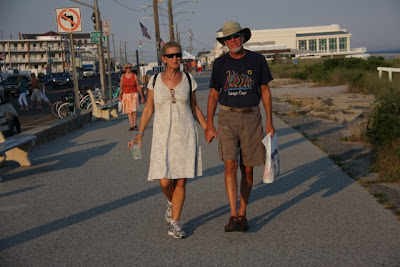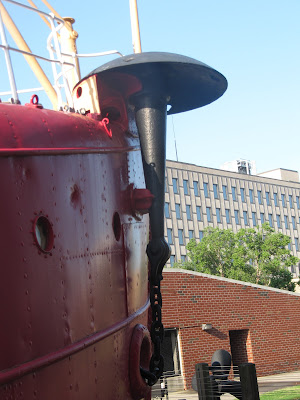Apologies for paucity of photos; I was asleep at the switch
or forgot camera, or its battery failed -- so I will have to describe mostly with words.
These big boys are
not colliding in Charleston Harbor.
Here is a passing shrimper whose nets we managed to avoid,
and a few of the following flying critters hoping for a handout.

We entered North Carolina at Beaufort, at the end of a 35
hour, 207 mile, ocean voyage from Charleston.
We had planned for the possibility that it might take that
long but hoped for a shorter passage. We were well ahead of schedule during the
first day but had to motor sail most of the night and second day when the winds
just died out. NOAA’s 5 pm broadcast
mentioned thunderstorms so we swapped the genoa for the small jib. No
thunderstorms or other storms though we did see lots of lightning from under
the horizon to the west, in the direction from which such storms come. We had
waited for tropical storm Alberto to leave, and he took most all of the wind
with him, leaving too little to propel us. A big ocean swell was running however. We had
a brief visit just before dark: a dolphin jumped clear out of the water about
10 feet off our quarter and the members of his small pod played with us until
their shapes became indistinguishable from the black crests of waves. The most
traffic we encountered was around the end of Frying Pan Shoal, which extends
many miles out from Cape Fear. There is a passage through that shoal marked by
a red and green and we probably could have made it through except: the chart
plotter had no scale below 6 miles, the red and green buoys are not lighted,
the moon was slight and the shoal was upon us at 1 am. So discretion won out
over valor and we took the longer way around. Once clear of the shoal I got about three
hours rest while Lene stood watch. Having plenty of time before dark, we gave
the motor a few hours rest and sailed most of the way into the harbor, during
which a half hour of 18 knot wind came up and we were glad that I had resisted
the temptation to put back the Genoa.
Our friend Dean, of Autumn Borne, had suggested anchoring at
the old Coast Guard station at Fort Macon to the left of the wig well marked
Beaufort Inlet. It looked good on the chart, but Dean contacted us by email,
VHF and cell phone, when these came alive as we closed the shore. He advised
that with the direction of the wind that had come up at last, this would have
been an extremely rolly anchorage. So we ended up anchoring at the town of Beaufort, off from the town
docks.
Lene got a phone call as she was steering slowly past the docks of the marina on our way to the anchorage and all I heard was: “Is this a joke?”
But it wasn’t. Bob, of “
Pandora”, another of the 53 Saga 43s that were built before
the company went bankrupt was the caller. I had helped him sail Pandora from
Norwalk to Mystic last summer, as described in a posting to this Blog. Bob was helping another friend with two other guys sail “The Abbey,” a 55
foot sloop from Nassau, Bahamas to New York. He was standing on The Abbey’s
dock, recognized ILENE and gave us the call. No joke. After the anchor set we
lowered the dinghy and brought over a bottle of wine to celebrate our
unexpected meeting. The Abbey, Bob with Lene:
I had visited Beaufort last year while helping to bring “Sea
Leaf” up from Florida and did not go ashore; Lene did -- to deliver garbage from our two days at
sea in the proper receptacle. We dined aboard, rehoisted the dink to its davit
and got an early start the next morning – but not quite early enough: The
bridge at Beaufort opens on request only once an hour so we had to drift for 48
minutes for the 8 am opening.
A short 38 mile day brought us to Oriental NC, actually to
the
River Dunes Marina, in Broad Creek, off the Neuse River. Oriental is named after a bit of wreckage of the
sailboat “Oriental’ which washed up there. It is the self proclaimed sailing
capital of North Carolina. Folks say that they have about 800 residents and
2500 boats. The Neuse is claimed to be
the widest river in America, though certainly not the longest or deepest. Its
width creates a body of water like some stretches of Long Island Sound for
pleasure sailing. We beat our way down
the Neuse in heavy winds with engine and small sails. At the end, we furled our
sails and headed directly into the wind using only the motor, which took as
much time as sailing the zig zag, because our speed was so much lower.
Our reason for calling on Oriental was to see Bill and
Sandy, who we met in Maine in ’08 and we had last seen in Iles des Saintes, during our passage
south last winter. They keep their boat, “Lucille,” another of the Saga 43s, at
River Dunes. It is quite a nice Club, made by
dredging a channel to a shallow lagoon and deepening it, and hence well
protected in hurricanes. They provide a free loaner car for two hours at a time:
“just put some gas into the tank,” wifi, a health club, showers, and quite a
good restaurant. They charge only $1/foot per night which is quite a bargain here in the States.
The developer bought lots of surrounding land with the idea of building a community
of homes, but the recession has put a hold on those plans. Lene had a bad allergic attack here,
later diagnosed as a cold or flu of some sort. (She is all better again after three punky
days.) All she wanted to do was to lay alone in her berth, sniffle, cough and
drink tea. Thus, on our planned lay day in Oriental, Bill and Sandy took me on
a tour of the county, including the towns of Lowlands (the land there is very low)
Hobucken (almost like Frank Sinatra’s home town) and Aurora, which was
celebrating its annual Fossil Day. One highlight of Fossil Day was a free one
hour guided motorcoach tour of the pit mine and plant of Potassium Corporation
of Saskatchewan. They mine potash, used in fertilizer and a lot of other
things, using huge cranes which they call drag lines, that drag up buckets of
earth. Two cars can be parked in one bucket!
They skim off the top 60 feet of dirt (“overlay”) to reach the 30 feet
thick layer of the sought after potash, use lots of water to wash it, clean the
water and then put the dirt and clean water back in place. Monster dump trucks
transport what the drag lines pick up. Our narrator had worked in the mine all
his life, as has his dad, and his pure NC accent reminded me of my friend KC.
Potash is the result of a sediment of animal bones and there are many fossils
in the dirt and a fossil museum in town, where the festival was held, which we
also visited. Several collectors of
fossils were displaying and selling specimens of their collections. The company
spreads a few yards of dirt outside and kids are given shovels and frames with
screening to sift through the dirt and finding tiny fossilized sharks teeth. Bill and Sandy helped us with the hazards of
the next few day’s navigation and provided medicine for Lene. They are great
folks who we hope to see in NY on their way to Maine this summer. The cats were
out on the docks all night, and Whitty had a panic attack when he jumped onto
what he thought was ILENE, but in
fact it was Lucille; he woke up the whole marina with his loud hysterical yowling, I’m afraid.
Here is Alfie are after a hard night’s dock prowling.
Our next anchorage was off to port at the
south end of the Alligator – Pungo River Canal, 46 miles from Oriental. We
cast off at 9:15 and dropped anchor here at 4:35 with three hours of pure peaceful
quiet sailing and the rest motor-sailing with the small sails. The anchorage’s
marsh grasses provided lots of wave protection but none from wind and were the
apparent source of the insects that we had to screen out; those that got in
were hunted down and killed by Lene and the kitties. There is room in that anchorage for many
boats but only two others were with us that night, lots of privacy and
room for lots of scope on the anchor to prevent dragging. A brief heavy rain during the night, after
Lene won the card games, caused us to dry out the cockpit cushions the next
morning before getting underway.
The Alligator – Pungo
Canal was in the first 20 miles of our 69 miles to Coinjock. We had
the sails up the whole way but the motor was on because with so much ground to
cover we did not have the luxury of turning off the noise maker. And it was
particularly noisy because the locking nuts that hold the cutlass bearing to its strut
had worked loose causing a terrible loud rattle of the propeller shaft.
Our first obstacle was the bridge over the
canal, close to its southern end. This bridge, unlike all the other “high”
bridgeson the ICW, is not 65 feet but only 64 feet above the water at high tide (and
there is only six inches of tide because it is so far from the sea). The
problem is that if winds have blown hard enough and long enough in the wrong
direction, the water level can be driven upward, possibly causing the bridge to
take off our mast. Here is an approach to a 65 foot bridge, not the one in
question (which we were too afraid to photograph):
But the wind had cooperated, we slowed to a crawl and we were OK. In the
canal the wind only got to us at places where the trees let it in, so it came
in puffs, heeling the boat from time to time.
A brief heavy rain caused me to re-dry the cockpit cushions. A crossing
of Albemarle Sound would have provided good sailing for twelve miles with no
narrow channel to worry about, but darn: the wind died there.
We passed homes of people who have forgotten (or never learned) that the South
lost the civil war. Confederate flag and rising sun.
We also passed homes whose residents, hawks, don’t mind bright
lights at night:
And we passed some heavy traffic in the narrow canals:
I had enjoyed the prime rib at Coinjock when stopping there
aboard Sea Leaf last summer and wanted Lene to experience it. I declined their
featured 32 oz. hunk in favor of one half that size which Lene shared.
The marina is one long seawall along the starboard side of the canal, as one is
heading north. They had a mechanic with diving equipment
which dove under the boat and tightened up the loose nuts and ended the rattle.
The engine continues to hum but without the rattle accompaniment.
All told, four passages, aggregating 361 nautical miles, and four ports of call
brought us from South Carolina to near the Virginia border.


























































